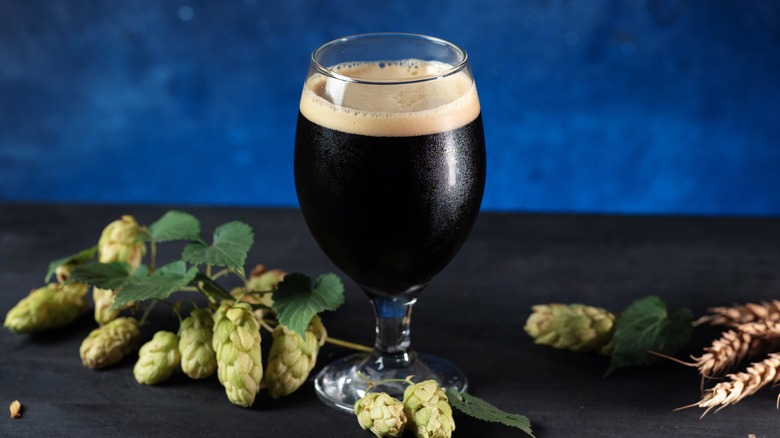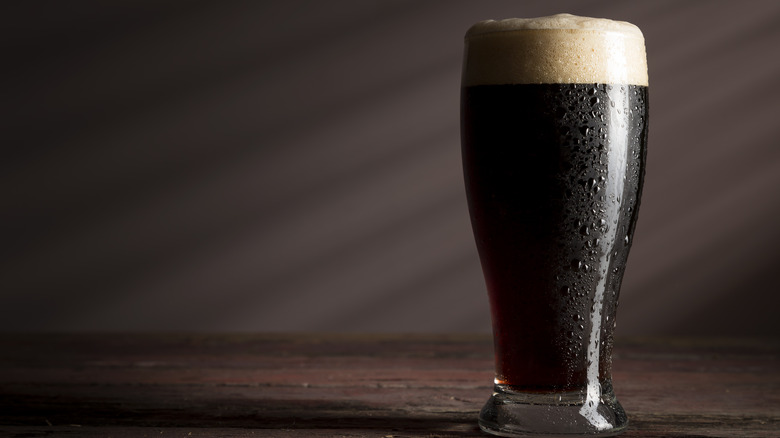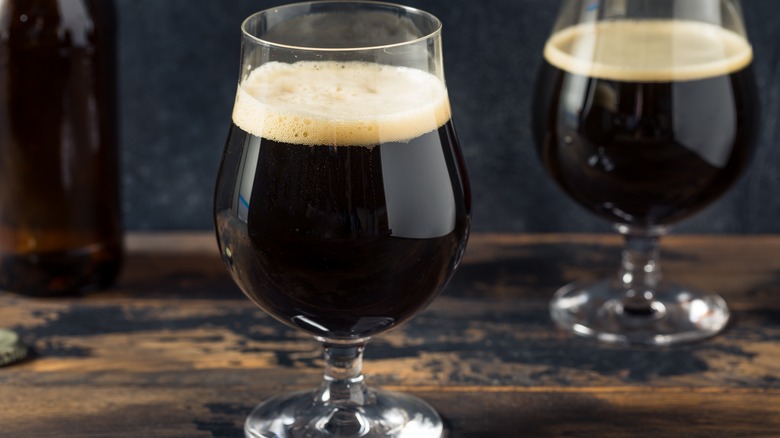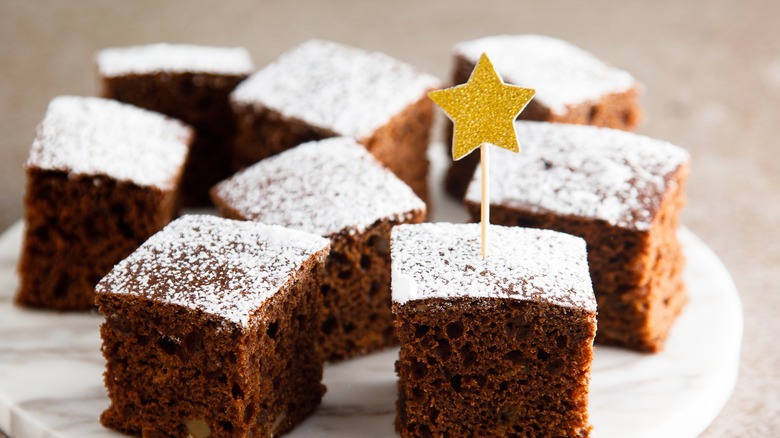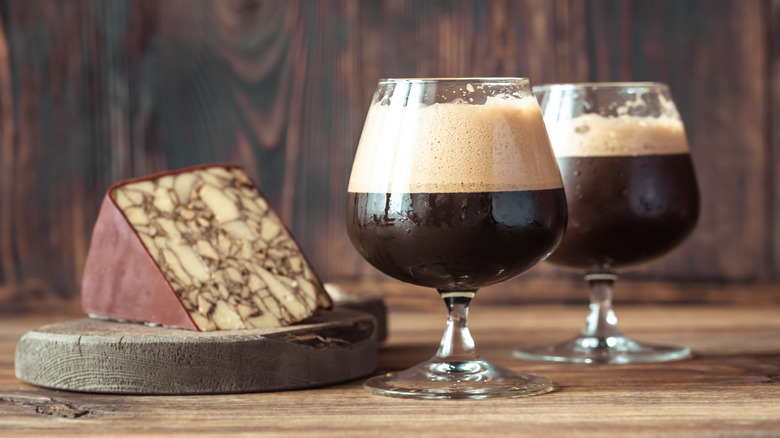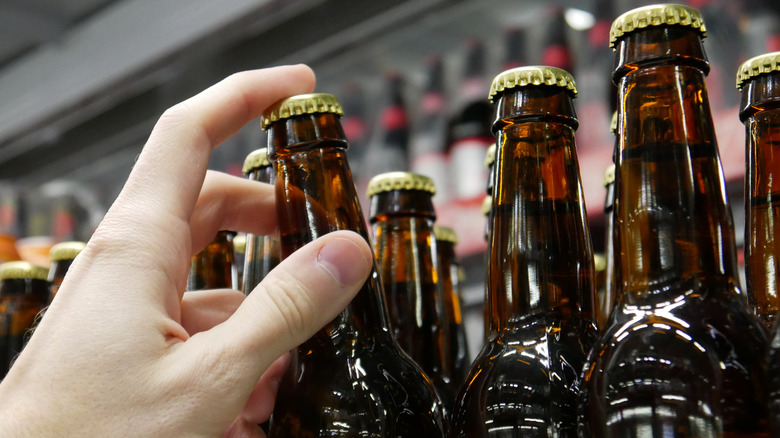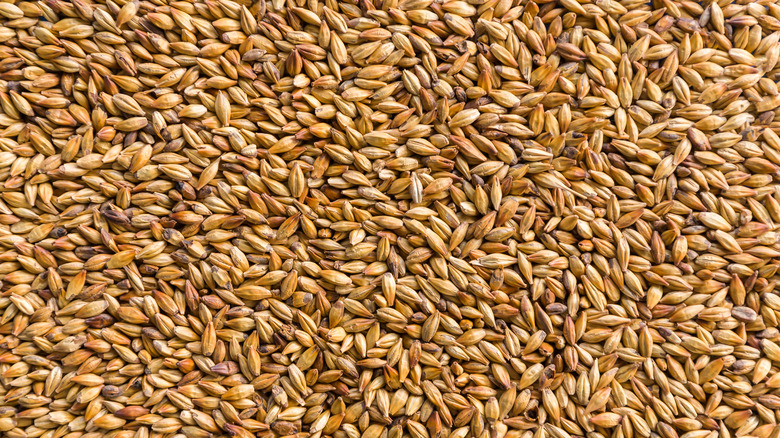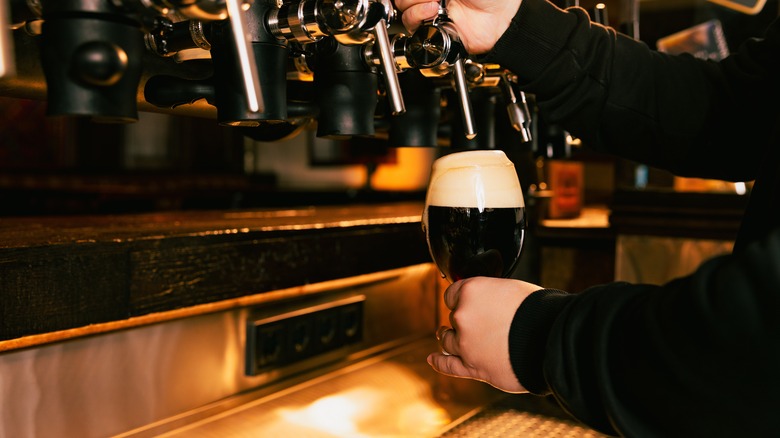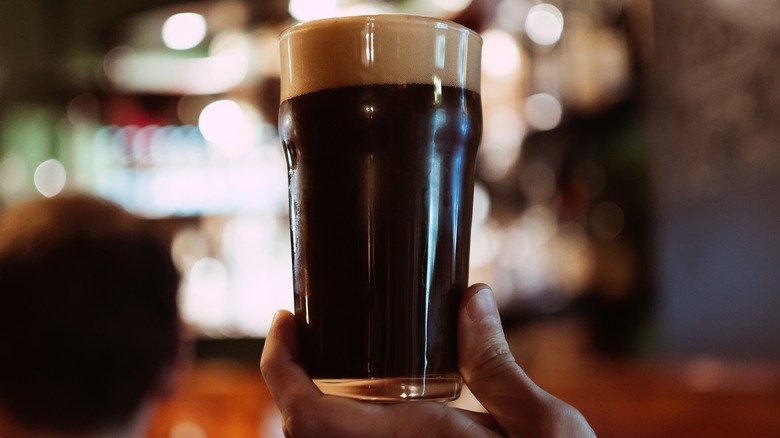What Is A Porter Beer, And How Is It Different From Stouts?
We may receive a commission on purchases made from links.
It's called "a pint of plain" in Ireland, but in Britain, porter is the only name you'll see on the draft list. It's a variant of brown ale that's defined by its smooth medium body, a malted character, and confectionary flourishes ranging from nuts and chocolate to strong coffee. Once a relic of back-breaking drudgery, nowadays the porter remains in ample rotation at microbreweries and taprooms. But between the shadowy color and mocha-esque flavoring, beer aficionados may have a hard time telling it apart from its close cousin, the stout. When both ales are dark and satiate the soul on a chilly evening, identifying them out of a beer lineup by appearance, smell, and taste is going to be an uphill battle.
So, we spoke with master brewers to get the inside scoop over these two drinks — and the undeniable dualities between them. "You'll find a hundred different thoughts and ideas on the internet on what really makes them different," says Brad Young, head brewer of Cape May Brewing, though there are slight distinctions to keep in mind when separating the two — namely the profile. "I always look for something on the lighter side for porters and something more robust and deeply roasted for stout." Assuming your curiosity's gotten the best of you, let's delve into the dark side to see what porters are, and if they really are different stouts.
History of porter beer
Whereas some beer innovations are credited to a single figure (see the 18th century origins of the IPA), the porter's roots can be attributed to a time and place. English pubs in the 1700s saw bartenders or "publicans" pouring brown ales that they would take the liberty of aging on-site. Soon enough though, the brewers began doctoring their recipes. Times were changing, and upswings in modernizing the process made experimentation common with ingredients (in this case, darker types of malts) as well as fermenting the brews prior to sending them off to watering holes. This created a substantially denser beer than what Londoners drank before. The name is typically from the demographic of London's labor class — "porters" — who, according to beer historian Martyn Cornell, swilled the calorie-dense brew while bearing the loads that kept society afloat throughout the era.
Where did the transition to "stout" occur? The way Beerwulf puts it, the word "stout" came in as a descriptor of porters touting a boozier disposition. Assuming you ordered a "stout porter" during this time, you'd receive a dark ale that looked the same, but certainly tasted bolder and brasher. For that reason, the sturdier rendition was infinitely more attractive to drinkers than the original, and by the mid-20th century, the sight of a porter was rare, if not virtually extinct. It took a few decades for the porter to percolate again, this time by American brewers toying with its distinctive style.
How is porter beer made?
Batches of porter, Masterclass writes, lean on a basic composition to endow the beer with depth and complexity — water, yeast, and some sort of dark malt. When a beer is malted, it's referring to the task of steeping the grains in water (this coaxes the plant into germination) before toasting them. From there this forms the foundation of the brew's body, lending it the depth and robust aromatics that define porter more broadly.
"Like all ales, porters are brewed with top-fermenting ale yeast," Natalie Cilurzo, president of Russian River Brewing, explains. This alludes to the process during brewing wherein the funky microorganisms bubble up, rather than downwards, to the surface of the vat. "Hop character is only present in the background" of the classic recipe according to Edelson, although modern breweries are apt to tweak the ratios of hops — and variants — as they see fit.
Edelson notes that crafting porter, at the end of the day, will resemble the bulk of most beer-making regardless of additional hops or adjuncts tossed into the batch. Stouts are also brewed with the four base ingredients listed above, so by that metric, the recipe alone almost makes them a direct match.
The difference between porter and stout
Now that we've covered some basic background, let's hop into the key facts defining the porter and stout. Typically, beer experts distinguish a porter by the presence of malts, in addition to a milder alcohol level, or ABV. A pint on average can net 4% or 5%, although plenty, including imperial styles, eschew tradition with ABVs that can veer higher than an authentic stout. Porters possess a chocolate-y hue that can range from dark brown to deep mahogany, versus the nearly-opaque blackness that is prevalent among stouts. To its credit, stouts are also dark with spiced, espresso-like undertones, but it's that un-malted, roasted barley that grants its telltale harsher taste, especially next to the milder inclinations of the porter.
Another tidbit to consider when analyzing your pint won't have to do with the contents inside the glass, but rather the region. Although both drinks descended from the U.K., stouts managed to amass its following in Ireland, propelled partly by the launch of Arthur Guinness's namesake empire. Porters, on the other hand, are synonymous with English tastes. "Historically, Britain and London specifically is considered birthplace of porter," reveals Edelson.
What does porter beer taste like?
Talking about the background and build, it's now time to talk about the porter's taste. Due to that malted barley, a pint will skew in the direction of confectionary sensations. Caramelized, toffee-candy essences mingle with heartier foundational flavors, primarily chocolate and hints of mocha. Letting the malts linger on the tongue, those aromatics flourish with the help of hops infusing a little acidity around the edges. A slight acridity is displayed, in the vein of a bar of dark chocolate or drip coffee, per Lowercase Brewing, and it's light on the fizzy carbonation.
"Fear of the dark" is what brewer Mark Edelson of Iron Hill Brewery claims makes people skittish to the draft. This is because looks-wise, they share zero resemblance to the easy amber ales we chug at ball games and picnics. Fact of the matter is, the severe opaque finish is all bark, no bite. Edelson finds "most are medium bodied and highly drinkable beers," so in lifting a glass to your mouth, you'll encounter a drink that's surprisingly approachable on the tastebuds.
While these palate-coating qualities do apply to stouts, thanks to that roasted barley you'll detect deeper coffee tones and higher amounts of acidity on the tongue. "If you are looking for more roasty, toasty flavors and aromas, go with a stout," advises Cilurzo. "If you like chocolate, malt and a little more sweetness, I recommend a porter."
Cooking -- and baking -- with porter beer
Judging from culinary circles, porter seems to be a popular beer to incorporate into recipes — and for good reason. Cooking with it heightens the richness and complexity of whatever dish you're making, and traditionally favors meals that are heavy on lip-smacking savoriness. The easy spiced aromas work well in comfort foods, and the more protein, the better. Stews, roasts, and charred barbecue are excellent canvases for delivering extra flavor. "You can't go wrong adding half a can of porter to a pot of chili, or, if you want to get fancy, braise some short ribs in a nice porter beer," Young says. "Serve that on a bed of mashed potatoes with a veggie and you'll impress anyone."
From Edelson's perspective, home chefs should be careful cooking with porter since "heating and reducing them can really bring out the bitterness of the roasted malts." Instead, he suggests using it as an enhancement to secondary embellishments — per Cilurzo, that could be a rich glaze or sauce. For the Beer-Brined Pork Chops Iron Hill Brewery serves, the taproom takes Pig Iron Porter (5.4% ABV) and authentic maple syrup to whip up a brine. This infuses the cutlet with heartier flavor, yet with a caramelized essence that brings out the succulence of the meat.
Splash some porter into your homemade barbecue sauce for ribs. Or, add it to scratchmade brownies to really "wow" at your potluck party.
Foods to pair with porter beer
Sipping a brew to the last drop is enjoyable enough. But there's no doubting a knock-out beer pairing can take the drink to elite levels. The decadent richness of porter plays well with a menu catering to hearty morsels, and because spicy food and beer go hand-in-hand, embracing flavor is a must. Edelson points to prime cuts of steak and Mexican sauces such like Mole as solid accompaniments fit to imbibe with. Young likes to opt for a pizza topped with jalapeño, hot honey, and crispy pepperoni. What about if you have a sweet tooth? The creamy mouthfeel will really up the ante when joining baked goods, especially if chocolate is involved (though peanut butter and coconut are well-documented foils). "Chocolate desserts are quite popular with Porters due to the complimentary aromas and flavors," says Cilurzo.
Earthy, pungent, foods excel in tandem with the porter's velvety lushness, and there's simply no shortage of combinations for balancing the two. If you're in need of a little inspiration, the internet is rife with tantalizing possibilities. Curate a charcuterie board with cheeses like Gruyere or Stilton for a nutty funk, or treat your palate to an indulgent pork tenderloin (Cilurzo's recommendation). Obviously, a show-stopping confection will take a shine to porter, so why not go whole-hog with a slice of chocolate peanut butter pie?
Where to buy porter beer
Wondering where to track down your next six-pack? These days, retailers permitted to sell alcohol stock a wide selection of everything from imperial ales to pilsners and cider, so it's worth visiting grocery outlets to see what's in stock. Better yet, try to see if your city has bottle shops, which cater to clientele with an interest in curated, cutting-edge sips. Where to choose to purchase your porter, Edelson asserts, "is a matter of personal preference, convenience and availability."
Still, scouting out trustworthy businesses is crucial to avoiding drinks that have gone off or spoiled. "Beer is a very perishable product," as Cilurzo emphasizes, adding that "how a retailer handles it matters for freshness and quality." For that reason, it's never a bad idea to check out the drafts at your local brewery, which Young is a huge advocate of. "I would seek out my local breweries first, get them fresh from the source," he recommends.
But perhaps where you live, the premium craft scene hasn't caught up to the cities bubbling over with excellent choices of porter. Should your favorite bar be lacking, ordering your beverages online is a convenient way to access products outside your range. Just make sure you're up on the liquor laws near you, since every state is different.
Common varieties of porter beer
As seen by the array of options greeting you at the taproom, there are multiple styles of porter available on the market. The default style remains the English porter — caramelized, roasted, and a smidge bitter — though folks residing in the British isles will simply refer to it as a "porter." Robust and Brown porters are relatives to the standard porter, Vinepair notes, while American-made porters aren't afraid to amp up the hops, as well as tossing in adjuncts to the brew. Honey, vanilla, oats and cherries are commonly added in. And if you're drawn to extremes, the Baltic Porter features tongue-tingling flavors (molasses or stone fruits) with a crisper feel, as a result of integrating lager yeast and enduring cold fermentation.
Unsure about which one will strike your fancy? Craft enthusiasts like Young swear on sampling their hearts out any time they hit the pub, but it never hurts to go with what's intrinsically appealing to you. In Edelson's case, an authentic London porter always hits the spot with its stable ABV and clean, level sweetness. But Cilurzo and Young favor the bolder side of the spectrum, seeking out glasses of robust and Baltic-style porters, respectively.
The use of malts distinguish the porter
Although malts make up a wide variety of fermented ales, they're exceptionally important in terms of showcasing the porter's unique style. The notion that malts are a defining trait is something Young isn't afraid to acknowledge. "A lot of people will point to different varieties of roasted malts used, and that's valid," he says. By contrast, the notes of burnt java or baking chocolate that overwhelmingly waft off a pint of stout is, says Cilurzo, the roasted barley hard at work.
Londoners 300 years ago were swigging drafts consisting of brown malts, though it's likely for craft brewers today to scale up their recipes by utilizing numerous varieties. Explains Edelson, "these beers use a combination of pale malt, crystal malt, chocolate and black malt as well as some raw grains," which he goes on to add "will impart the wonderful color, mouthfeel and notes of roast and chocolate that are signature of this style."
Crystal malts double-down on the porter's velvety texture, with an incredible amount of brown coloring. And according to Simpsons Malt, an Imperial Porter will likely contain Imperial Malts, forming a high-octane base that's heavy in stature and hue.
Is cold weather the best time for sipping?
When is the "best time" for nursing a crisp pint of porter? You'd be correct saying the autumn and winter, considering by the flavors. Porters are well-suited to snowy nights huddled under a throw blanket, mystery novel in hand. However, the balanced profile offers enough versatility for regular sipping, regardless of what the calendar says. In fact, the stance among many brewers is that seasonality is in the eyes of the beholder.
"Porters can be consumed year-round, even on a hot day," attests Cilurzo, who reasons that short of the steeper varieties, it's a liquid that can go down as smoothly as any ice-cold wheat lager. Edelson echoes this, and though he acknowledges the light-dark dichotomy exists with drinking choices based off season, "there is, truthfully, no reason porter cannot be consumed all year long."
Revelers won't look out of place during a summer cookout, nor will they be blamed for waiting until fall to make those cozy pub crawls. Either circumstance welcomes the beer regardless.
How to store your porter
Understanding how to preserve your porter for the most optimal sipping experience is significant. To appreciate the fullness of its aromas and flavors relies on storing it properly until the point of opening your bottle. Dark ales of this style can withstand about six months prior to drinking (per Thompson Island Brewing Co.), but you want to make sure that wherever you put it is hospitable for long-term storage. Languishing in an environment that's irregularly heated causes the brew to grow funky (and not in the good way); if it's freezing, your tastebuds will be denied the sensational complexities that come with drinking porter in the first place.
So what do experts recommend? From Edelson, it's better to leave your drinks somewhere on the colder side. "Beers are carbonated with CO2," Cilurzo explains, adding that "the warmer they get, the more oxygen is released thus accelerating the oxidation process." That's why when stashing it away for later, keep it in a dry, temperate place — set between 45-degrees to 55-degrees, per Hop Culture — so that the beer's characteristics don't decline.
That being said, "darker beers are certainly ones that you should let warm up a bit," according to Young, so once you open it for sipping (he suggests a tulip-shaped glass), it's acceptable if it reaches room temperature.
